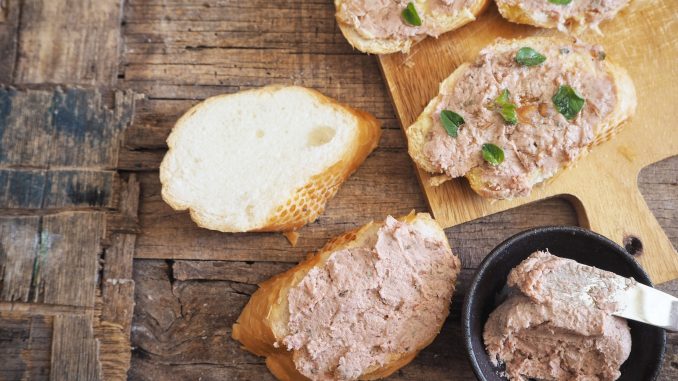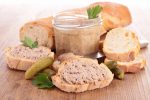
Brussels liver pâté, a delectable culinary creation, has a rich history that traces its origins back to the heart of Belgium. This savory spread, with its smooth texture and robust flavor, has evolved over centuries, reflecting both the changing gastronomic preferences of the region and the art of culinary craftsmanship.
History Behind Brussels Pate
The history of Brussels liver pâté intertwines with the broader history of pâté in Europe. Pâté, which means “paste” or “pie” in French, has ancient roots dating back to Roman times. However, it was during the Middle Ages that the concept of pâté truly began to flourish, as various regions developed their unique takes on this versatile dish. The use of liver in pâté became particularly prominent due to its rich and indulgent taste, and it quickly found its way into the palates of nobles and commoners alike.
Brussels, as the capital of Belgium and a hub of culture and commerce, played a pivotal role in shaping the evolution of pâté. The city’s culinary landscape was influenced by a convergence of French and Flemish culinary traditions, resulting in a distinctive fusion of flavors. The availability of ingredients like liver, spices, herbs, and butter in the region facilitated the development of innovative pâté recipes.
In the late medieval and Renaissance periods, pâté gained prominence as a centerpiece of feasts and banquets. Its preparation became an art form, and skilled chefs experimented with various ingredients and techniques to create exquisite variations. Liver pâté, in particular, stood out for its luxurious taste and smooth texture, making it a staple at noble tables.
During the 18th and 19th centuries, as culinary practices continued to evolve, Brussels liver pâté evolved alongside them. The rise of professional kitchens and the dissemination of culinary knowledge through cookbooks contributed to the refinement of pâté recipes. While liver remained a central ingredient, new spices, herbs, and even alcohol were incorporated to enhance the flavors and aromas.
By the 20th century, as Belgium and its cuisine experienced various social and cultural shifts, Brussels liver pâté underwent a transformation. The dish transitioned from being a predominantly aristocratic indulgence to a more widely accessible culinary delight. This democratization was fueled by changes in the socio-economic landscape, advancements in food preservation techniques, and the emergence of a more diverse array of eateries.
The modern era witnessed the standardization and commercialization of Brussels liver pâté. Food manufacturers began producing canned and packaged versions of the delicacy, allowing people to enjoy it beyond the confines of upscale restaurants. At the same time, traditional recipes persisted in family kitchens and local eateries, preserving the authentic essence of the dish.
In recent decades, the global interest in diverse cuisines has spurred a renewed appreciation for Brussels liver pâté. Culinary enthusiasts and chefs have revisited classic recipes while adding their own innovative twists. Local markets and artisanal producers have also embraced the demand for high-quality, artisanal liver pâté, catering to individuals who seek an authentic and flavorful experience.
The history of Brussels liver pâté encapsulates the culinary journey of a region. From its humble origins as a medieval delicacy to its present-day status as a beloved spread enjoyed by people of various backgrounds, this dish has embodied the evolving tastes, traditions, and techniques of Belgian gastronomy. Whether served on crusty bread, as an appetizer, or as part of a charcuterie board, Brussels liver pâté continues to captivate palates, offering a taste of history with every bite.
This classic meaty Brussels pâté is a wonderful dish for an appetizer or starter. This pâté is always smooth in texture but firm enough to be added as chunks or a garnish even for other meat dishes. Try it on crackers or chunks of French bread and some chutney.
A good combination would be this pate with a small portion of rhubarb chutney.
[Please note we are an affiliate marketing partner and will make a sales commission if you purchase any items through our affiliate links. Please read our affiliate disclosure]
Essential Equipment
- Food Processor or Blender: For blending the ingredients into a smooth or chunky consistency, depending on the type of pâté.
- Mixing Bowls: For combining ingredients before processing.
- Knife and Cutting Board: For chopping ingredients like liver, vegetables, or herbs.
- Saucepan or Skillet: For sautéing ingredients like onions, garlic, or liver.
- Sieve or Fine Mesh Strainer (optional): For achieving a smooth texture if desired.
- Loaf Pan, Terrine Dish, or Ramekins: For shaping and chilling the pâté.
- Spatula or Spoon: For transferring and smoothing the pâté mixture into the dish.
- Baking Dish (for terrines): If baking the pâté in a water bath.
- Cling Film or Foil: To cover the pâté while it chills, preventing it from drying out.
- Thermometer (optional): To ensure safe cooking temperatures, especially for meats like liver.
Optional Equipment:
- Mortar and Pestle: For grinding spices.
- Pastry Brush: For brushing melted butter or clarified fat over the pâté to seal it.
- Kitchen Scale: For precise measurements of ingredients.
- Decorative Moulds: For making pâté in specific shapes.
Ingredients
- 1 lb (450g) pork liver
- 1 lb (450g) ground pork from shoulder and/or leg.
- 1 small onion or two shallots, finely chopped
- 2 cloves of garlic, minced
- 4 tablespoons unsalted butter
- 1/4 cup (60ml) brandy or cognac
- 1 teaspoon dried thyme
- 1/2 teaspoon dried rosemary
- 1/2 teaspoon ground nutmeg
- Salt and pepper to taste
- baguette slices or crackers, for serving
Preparation
- Rinse the pork liver under cold water and pat it dry with paper towels. Trim off any connective tissue or membranes, and cut the liver into small pieces. Use as soon as possible once it has been cleaned.
- In a large skillet or frying pan, melt 2 tablespoons of butter over medium heat. Add the chopped onion and minced garlic, and sauté until the onion becomes translucent and fragrant, about 3-4 minutes.
- Add the pork liver to the skillet and cook until it is browned on the outside but still slightly pink on the inside, about 3-4 minutes. Remove from heat and let it cool for a few minutes.
- In a food processor or blender, combine the cooked pork liver, ground pork, brandy or cognac, dried thyme, dried rosemary, ground nutmeg, salt, and pepper. Process the mixture until smooth and well combined, scraping down the sides of the bowl as needed.
- In the same skillet used for cooking the liver and onions, melt the remaining 2 tablespoons of butter over medium heat. Add the pork liver and ground pork mixture to the skillet, and cook, stirring occasionally, for about 8-10 minutes, or until the mixture is cooked through.
- Remove the skillet from heat and let the mixture cool slightly. Transfer it to a food processor and blend again until the pâté reaches a smooth and creamy consistency.
- Taste the pâté and adjust the seasoning if needed by adding more salt, pepper, or herbs.
- Transfer the Brussels pâté to a serving dish or individual ramekins. Cover and refrigerate for at least 2 hours, or until it firms up and the flavors meld together.
- Serve the Brussels pâté chilled or at room temperature with baguette slices or crackers. It makes a delicious appetizer or spread for sandwiches.
Note: It’s important to handle raw liver carefully and ensure it is fully cooked to avoid potential health risks. Make sure to cook the liver thoroughly during the cooking process.
Nutritional Values per 100 grams (Approximate):
- Calories: Approximately 280 – 310 calories
- Protein: Approximately 13 – 15 grams
- Total Fat: Approximately 22 – 24 grams
- Saturated Fat: Approximately 8 – 10 grams
- Cholesterol: Approximately 220 – 240 milligrams
- Sodium: Approximately 110 – 130 milligrams
- Carbohydrates: Approximately 1.5 – 2 grams
- Fiber: Approximately 0.2 – 0.4 grams
- Sugar: Approximately 0.3 – 0.5 grams
Please remember that these values are estimates based on the provided ingredients. The assumption is a total cooked weight of around 900 grams.
Keep in mind that the specific nutritional content can vary depending on the fat content of the ground pork and the specific nutritional information for the brandy or cognac used.

The first pate recipe I have found which actually produces what I thought it should do. I know that these foods are not to everybodys liking but in Rwanda you have to use whatever is to hand. We have lots of liver leftover from keeping pig. I love your site – we use your site at school.